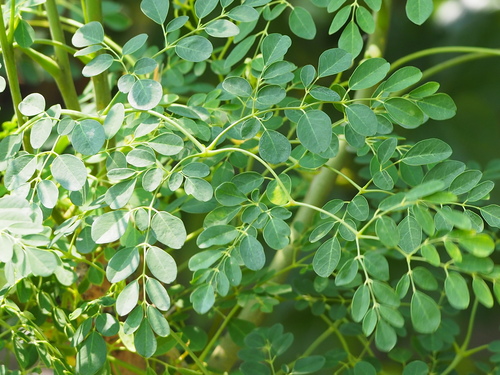Botanical name: Moringa oleifera | Hindi: सहजन | Marathi: शेवगा | English:Moringa
About
The Moringa tree, also known as the drumstick tree or horseradish tree, is a fast-growing, drought-resistant tree native to the Indian subcontinent. It can reach up to 10-12 meters in height and has a slender trunk with feathery, compound leaves. The leaves are bright green and arranged in pairs, with each pair measuring up to 30 cm long.
The most striking feature of the Moringa tree is its flowers. They are white, fragrant, and arranged in drooping clusters. The flowers are followed by long, slender pods (drumsticks) that can grow up to 45 cm in length. These pods contain small, brown seeds that are edible when roasted or ground into a powder.
Interesting Facts

Medicinal Uses: Moringa has a long history of medicinal use in traditional medicine systems around the world. The leaves, pods, flowers, and seeds of the tree are all believed to have various health benefits. The leaves are a rich source of vitamins, minerals, and antioxidants, and they are believed to boost the immune system, improve digestion, and reduce inflammation. The pods are a good source of protein and fiber, and they are used to treat malnutrition and anemia. The flowers are believed to have antibacterial and antifungal properties, and they are used to treat skin conditions and wounds. The seeds are a good source of oil, which is used to treat skin problems and as a hair conditioner.

Environmental Impact: Moringa is a valuable tree for the environment. It is fast-growing and drought-resistant, making it a good choice for planting in areas with limited water resources. The tree also helps to fix nitrogen in the soil, which improves soil fertility. Additionally, the tree’s roots help to prevent soil erosion.

Food & Culinary usage: Moringa is a versatile ingredient that can be used in a variety of dishes. The leaves can be eaten fresh, cooked, or dried and powdered. They have a slightly bitter taste and can be used in soups, stews, salads, and smoothies. The pods can be eaten raw, cooked, or pickled. They have a slightly sweet and nutty flavor and can be used as a side dish or vegetable. The flowers can be eaten fresh or cooked, and they have a sweet and delicate flavor. The seeds can be roasted and ground into a powder, which can be used as a coffee substitute or added to baking.

